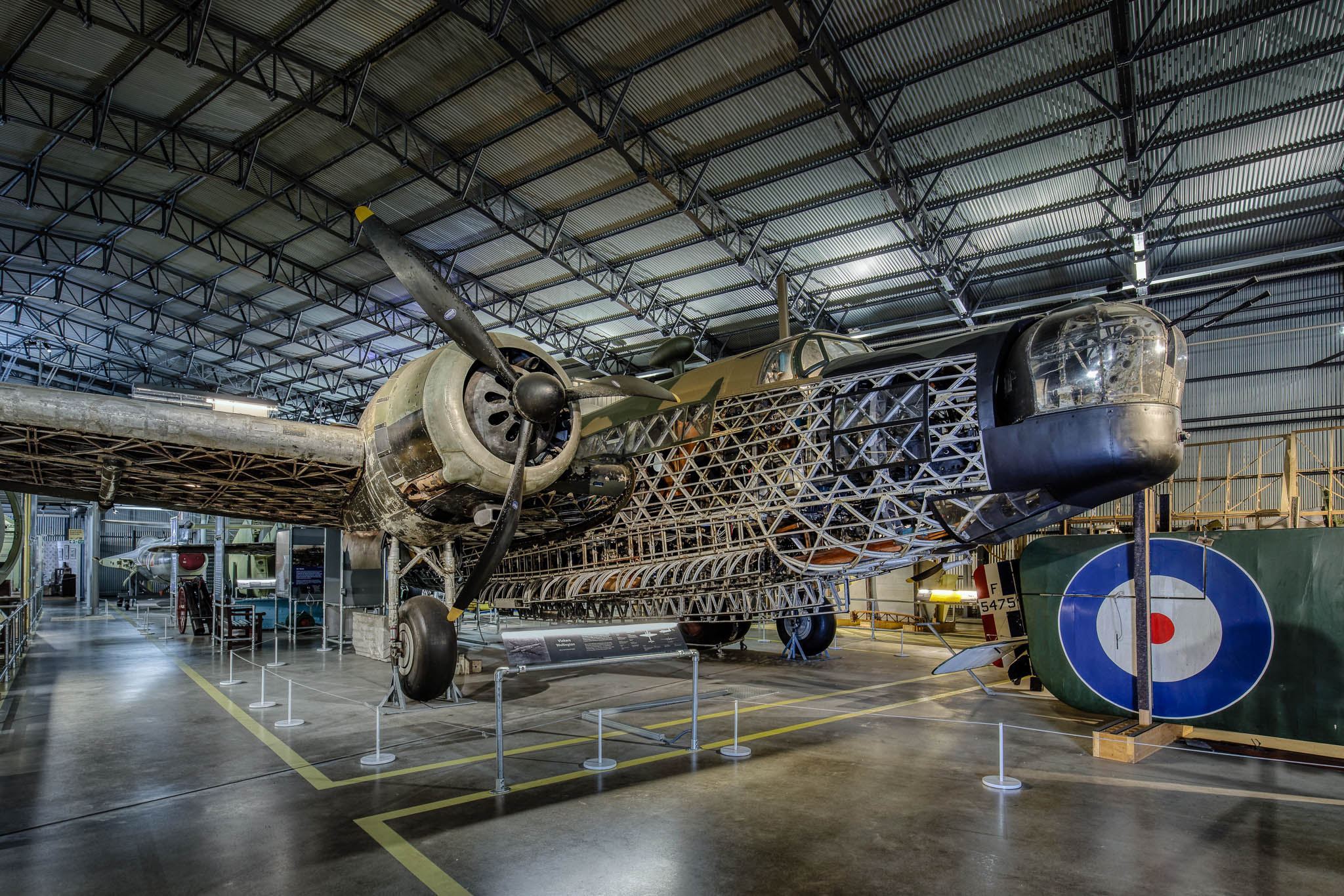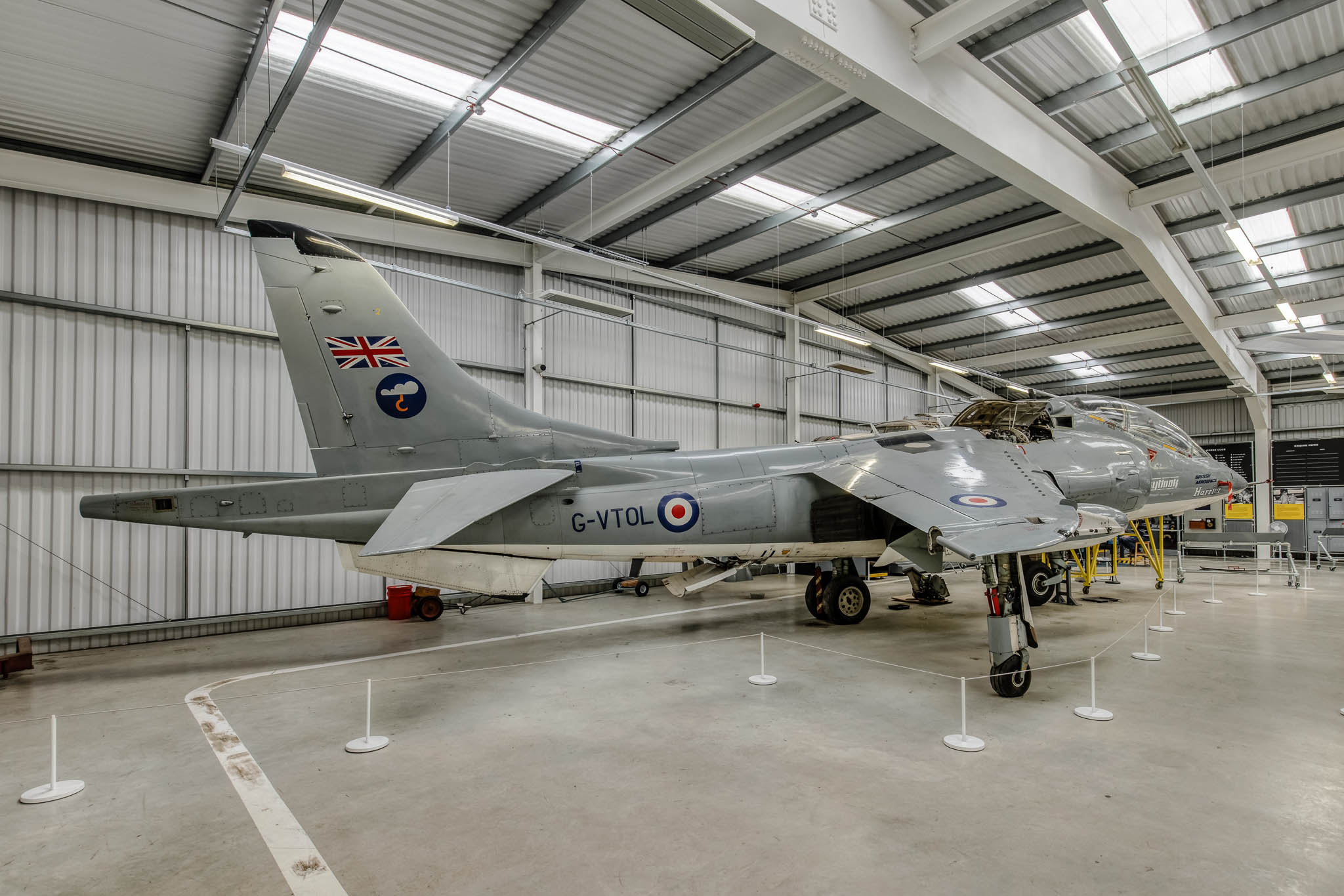Brooklands Museum
Weybridge, Surrey
July 2025
|
| Brooklands Museum is a motoring and aviation museum opened in 1991. Brooklands was the birthplace of British motorsport and aviation such as aircraft companies such as Bleriot, Hawker, Sopwith, Martinsyde, and Vickers. |
 |
Left to right: Vickers Wellington 1A (N2980 'R'). The prototype long range medium bomber first flew at Brooklands in 1936. Its geodetic structure, designed by Barnes Wallace, was able to absorb heavy damage and its flexible design made it the only multi-engine aircraft to see service throughout World War Two.
On December 31, 1940, N2980 while on a navigational exercise, lost the power in one engine and ditched into Loch Ness. It was serving with 20 Operational Training Unit (OTU), based at RAF Lossiemouth in Scotland. It was a veteran in the early part of World War Two, surviving raids against the German Navy, including what was known as the Battle of Heligoland Bight, where only ten Wellingtons returned of the 22 that took part. Even though the Wellington could take a lot of punishment from enemy gun fire, they were still vulnerable to flak gunners and fighter pilots armed with 20mm shells during these daylight raids.
N2980 was discovered in 1976 by an American team searching for the mythical Loch Ness monster. It was not until 1984 that a charity named the Loch Ness Wellington Association was formed, to raise funds for the recovery of the rare aircraft. On September 21, 1985 it was brought to the surface and six days later it was back at her birthplace of Brooklands.
The restoration with over 100,000 hours by volunteers hours was completed ten years later. It was decided that the geodetic airframe construction could be seen to full effect by only partially recovering the aircraft. This is one of two surviving Wellingtons from the 11,461 built (2,515 at Vickers Armstrong's Brooklands factory) and the only one to see active service during World War Two. |
| Left to right: Hawker Hurricane MK.IIA (Z2389 'XR-J'). Built in 1940 by Hawker Aircraft Ltd. at Kingston-on-Thames, then assembled and test flown at either Brooklands or Langley. As part of emergency war supplies for Russia, Z2389 was crated up and sent to Russia by sea. It joined 767 Regiment of the Red Air Force on the Kola Peninsula. On the June 20, 1942, it engaged two Messerschmitt Bf109Fs and five Bf110s over a remote part of Murmansk but was shot down along with two other Hurricanes. Fifty years later it was found by Russian historians and its remains were taken to St Petersburg in 1996, in 1997, the part-restored aircraft was first seen by World War Two recovery specialist, Jim Pearce, then inspected by Brooklands Museum and purchased with a Heritage Lottery Fund grant. |
 |
| Left to right: Vickers Viking 1 (G-AGRU). A twin-engine short-range airliner derived from the Wellington bomberand built at Brooklands by Vickers Armstrongs Ltd. The first Viking was flown from Vickers airfield at Wisley, Surrey, on June 22, 1945. Built in 1946 G-AGRU was sold to British European Airways (BEA) and given the name 'Vagrant', flying from Northolt Aerodrome. BEA operated the Viking until 1954. After service with many other operators it was purchased by British Airways in 1979 and donated it to Brooklands Museum in 1991, after a period at Cosford Aerospace Museum. Five other Vikings survive today of the 163 built. |
Left to right: Vickers Varsity T.1 (WF372 'T'). The Varsity entered service in 1951 in the multi-engine crew training and also the flight engineers, radio operators, navigators and for bomb aimers, it took over from the Wellington. 163 were built. WF372 was delivered in 1952 for RAF Training Command. Its last flight in 1976 was to Sibson, Peterborough for the Nene Valley Aviation Society to be used as their clubhouse. After the group wound up it was moved on to the Brooklands Museum in 1988.
BAC One-Eleven 670 (G-ASYD) inscribed 'Fly By Light Control Technology'. Built 1965 as model 400, it was later modified to 500, 475 and model 670 prototypes. It was in continuous use as a development aircraft for British Aircraft Corporation. Retired in 1993, it was flown from Filton to Brooklands Museum in June 1994 for preservation. |
 |
| Hawker Siddeley Harrier T52 (ZA250 registered G-VTOL) was the first two-seater trainer used as a demonstration aircraft by Hawker, showcasing the Harrier to foreign air forces. |
Left to right: Hawker P.1127 (XP984). The P.1127 was developed as a V/STOL ground-attack and reconnaissance fighter, this aircraft was one of six pre-production evaluation models built prior to the type’s adoption as the Harrier GR.1.
XP984 was the first example it made its maiden flight from Dunsfold on August 31, 1966. The last of the six P.1127 prototypes, it was the only one retrofitted with a swept wing.
Hawker Siddeley Harrier GR3 (XV741). |
Left to right: Hawker Hunter F51 (E-421).
Hawker Hunter F51 (E-412 painted as 'XF368').
Supermarine Swift F4 (WK198) prototype, which held the World Absolute Air Speed Record when flown by test pilot Mike Lithgow in Libya on September 26, 1953. |























